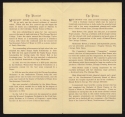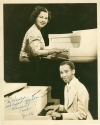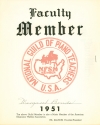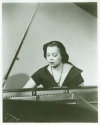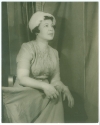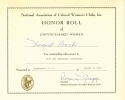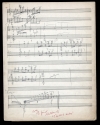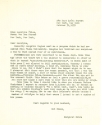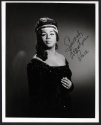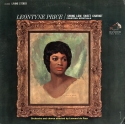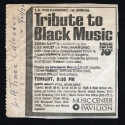See also the companion exhibition, Margaret Bonds and Langston Hughes: A Musical Friendship, currently in the Special Collections Gallery. The Margaret Bonds Papers(GTM 130530) are available to researchers in the Booth Family Center for Special Collections.
Introduction
Margaret Bonds (1913-1972) was a composer with a mission. The only child of Estella C. Bonds (a professional musician) and Dr. Monroe Alphus Majors (a physician, writer and political activist), she was raised in an environment that encouraged her interest in music of all sorts and instilled in her a deep commitment to her community. “I realized, very young, that I was the link … between Negro composers of the past,” Bonds explained in 1971. “And now, when I sit in the Philharmonic Hall or any of those places, I hear the young Negroes today, … [and] I think, if anything, if I deserve any credit at all, it’s that I have stuck to my own ethnic material and worked to develop it.”
1
Bonds’s parents divorced when she was four, but she remained close to both of them throughout her life. From her father, she inherited a passion for civil rights and community engagement; from her mother, a solid musical foundation and arts education. Estella Bonds was a charter member of the National Association of Negro Musicians, and her home served as a gathering place for many of the leading artistic and literary figures in Chicago’s African-American community, among them Will Marion Cook, Countee Cullen, Abbie Mitchell, Noble Sissle, Florence Price and Langston Hughes.
Margaret Bonds was a music prodigy, and by age 13 she had begun to compose. At age 16 she enrolled at Northwestern University, where she won awards in piano and composition. In 1933, at age 20, she became the first African American to perform as a soloist with the Chicago Symphony Orchestra.
- Citation awarded to Estella Bonds by the National Association of Negro Musicians on August 18, 1955.
- Title page from the book Noted Negro Women: Their Triumphs and Activities (1893), written by Monroe Alphus Majors.
- Program from the Chicago Symphony Orchestra’s Century of Progress series, featuring a performance of John Alden Carpenter’s Concertino for Piano and Orchestra with Margaret Bonds as soloist. June 15, 1933.
2
Bonds earned both her B.M. (1933) and M.M. (1934) at Northwestern University. After graduation, she remained in Chicago and earned a living pursuing a variety of musical activities, which included: composing, performing and teaching private lessons. Two of her most famous students from this era were Gerald Cook and Ned Rorem, both of whom stayed in touch with her throughout their careers.
- Margaret Bonds Promotional Brochure for the 1935/36 concert season
- Margaret Bonds, Three Miniature Portraits of Uncle Joe for piano solo. Autograph manuscript dating from the early 1930s. This is the only known copy of this early composition.
- Postcard from Ned Rorem to Margaret Bonds, dated February 14, 1959.
3
In addition to her activities in the realm of classical music, Bonds ventured into popular music. While in Chicago, she regularly played piano at the Palmer House Hotel and tried her hand at songwriting. Activities such as these increased when she moved to New York in 1939. Many of her songs, like “Peachtree Street,” tapped into trends in popular culture. Others confronted social issues connected with civil rights. The lyrics to “Three Wise Monkeys” references the racist viewpoints of three southern politicians: Theodore Bilbo, Eugene Talmadge and John E. Rankin.
- Margaret Bonds (music) and Andy Razaf (lyrics), “Peachtree Street” (New York: Georgia Music, 1939), composed for the film premiere of Gone with the Wind.
- Contract with Robbins Music for “Empty Interlude,” composed by Margaret Bonds (music) and Roger Chaney & Andy Razaf (lyrics). Dated January 16, 1941.
- Lyrics to “Three Wise Monkeys” with edits in pencil by Margaret Bonds. (Undated, ca. 1946).
4
In New York, Bonds revived her career as a performer. In addition to performing as a soloist grounded in the European classics, she also toured as part of a piano duo with Frances Kraft (1940-1943) and her former student Gerald Cook (1944-1948). With Cook, she regularly performed at the Café Society (New York’s only racially-integrated nightclub) and on radio broadcasts.
- Margaret Bonds & Frances Kraft Promotional Flyer for the 1940/41 concert season.
- Press clippings and business card of the piano duo Margaret Bonds & Gerald Cook (1944/45).
- Margaret Bonds & Gerald Cook publicity photograph, signed by Cook (1944).
- Program for Margaret Bonds’s solo piano recital at the historic Greater Bethesda Baptist Church in Chicago on September 17, 1950.
5
Throughout the 1950s, Bonds continued her work as a composer, performer and teacher. In addition to private lessons, she joined the staff of East Side House Settlement, a non-profit social services organization committed to serving New York’s underprivileged youth. At East Side House she taught weekly music classes, hosted performances featuring African-American composers, and served as music director for the annual spring musical.
- Certificate showing Margaret Bonds’s membership in the National Guild of Piano Teachers and the American Musicians’ Welfare Association (1951).
- Margaret Bonds Publicity Photograph (1952).
- Program for the musical Tom (a retelling of Mark Twain’s Tom Sawyer) at the East Side House in New York.
6
The highlight of Bonds’s career as a performer came in 1952, when she performed a solo recital at Town Hall in New York. Her friends and colleagues understood how important this performance was to her. Among the many letters and telegrams she received, the two she treasured most were those from the musician Abbie Mitchell and poet Langston Hughes.
- Letter from the National Concert and Artists Corporation to Margaret Bonds, dated May 3, 1950.
- Program and Publicity Materials for Margaret Bonds solo recital at Town Hall in New York on February 7, 1952.
- Telegrams from Abbie Mitchell and Langston Hughes to Margaret Bonds, dated February 7, 1952.
7
As the Civil Rights Movement gained momentum, Margaret Bonds became a tireless promoter of African-American artists. In addition to assisting songwriters like Andy Razaf secure royalty payments, she sponsored concerts and curated exhibitions featuring the works of black composers and poets. She also founded The Margaret Bonds Chamber Music Society, which was dedicated to establishing a canon of art music by African-American composers.
- Letter from Andy Razaf to Margaret Bonds, dated February 28, 1952.
- Margaret Bonds Publicity Photo (1956), taken by Carl Van Vechten.
- Letter from Clarence Cameron White to Margaret Bonds, dated December 30, 1956.
8
- Margaret Bonds, “Negro Artists that I Have Heard Perform…” Undated typescript with autograph corrections (ca. late 1950s).
- Press Release for the Exhibit of Music by Negro Composers (with personal comment added by Margaret Bonds), which opened at the Schomburg Library in New York on February 8, 1960.
- Honorary Certificate from the National Association of Colored Women’s Clubs naming Margaret Bonds to its Honor Roll (August 2, 1962).
- Ticket for the Countee Cullen Memorial Concert “Negro Music and Poetry,” performed by the Margaret Bonds Chamber Music Society on April 14, 1952.
9
The death of Martin Luther King, Jr. deeply affected Margaret Bonds. And in the 1960s, she composed several important works dedicated to his legacy as a crusader for civil rights.
- Telegram from Sammy Davis, Jr. and Peter Lawford to Margaret Bonds, dated January 3, 1961.
- Programmatic Description of The Montgomery Variations (1963) by Margaret Bonds.
- Margaret Bonds, The Montgomery Variations, autograph manuscript (1963).
- Margaret Bonds, preliminary sketch (ca. 1952) for Troubled Water, published in 1967.
10
In addition to her songs and instrumental works, Margaret Bonds dedicated a great deal of her time as a composer to creating modern arrangements of traditional African-American spirituals. Of the many singers who promoted Bonds’s music, Leontyne Price was undoubtedly the most prominent. Bonds and Price developed a deep respect for one another during the 1950s and 60s, which is reflected in their letters to one another and various collaborations. Bonds’s setting of “He’s Got the Whole World in His Hand” for Price in 1962 became one of her most popular, and profitable, recordings.
- Letter from Margaret Bonds to Leontyne Price, dated October 31, 1955.
- Autographed Photograph of Leontyne Price (ca. 1967) dressed as Elvira from Verdi’s Ernani.
- Leontyne Price, Swing Low, Sweet Chariot LP (1962)
- Program for Leontyne Price’s solo recital at the Arie Crown Theatre in Chicago, February 3, 1963.
11
In the 1960s, Bonds received numerous awards for her contributions to American music.
- Margaret Bonds, Typescript of a lecture on “Careers in Music for Women,” delivered at Fairleigh Dickenson University in Madison, New Jersey on March 24, 1962.
- Letter from the Detroit Civic Opera Company to Margaret Bonds, dated January 6, 1962.
- Program for the Margaret Bonds Concert at Wayne State University in Detroit on June 2, 1962.
- Margaret Bonds’s Northwestern University Alumni Association membership card (1956/57) and ASCAP membership card (1963).
- Article in ASCAP Today (1967) highlighting the recent achievements of various members, including Margaret Bonds.
12
Margaret Bonds was an indefatigable musician, committed until her final days to promoting the music of African-American composers. As letters home reveal, she continued to compose and tour extensively throughout the 1960s. And in 1967, she moved to Los Angeles to try her hand at writing film scores. The relentless schedule, however, eventually caught up with her. On April 26, 1972, she died unexpectedly of a heart attack. One month later, Zubin Mehta and the Los Angeles Philharmonic paid tribute to her life with a performance of her final major work, the multi-movement Credo for chorus and orchestra based on a text by W.E.B. DuBois.
- Letter from Margaret Bonds to her husband Larry and daughter Djane, dated March 14, 1964.
- Program for Margaret Bonds Memorial Service on May 2, 1972.
- Telegram from Leontyne Price to the Family of Margaret Bonds, dated April 28, 1972.
- Advertisement in the Los Angeles Times (May 21, 1972) for the LA Philharmonic’s Tribute Concert to Black Music, featuring the work of Margaret Bonds.
- Margaret Bonds, Credo, Autograph manuscript dated January 12, 1966.
Exhibition curated by Anna Celenza, Thomas E. Caesteker Professor of Music






